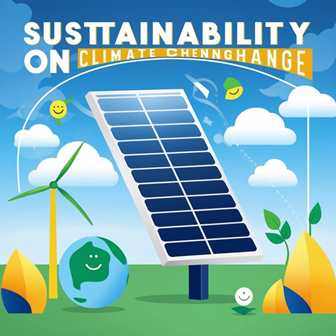5 Key Solar power Technologies for Sustainability
Solar power technologies are crucial in the face of climate change. It not only meets our energy needs but also protects the environment. By can combat climate change and strive towards a more sustainable future by using the most recent breakthroughs in solar power technologies.
In this blog, we will look at the newest solar power technology and how they may help battle climate change.
Solar Power Technologies: The Latest Innovations
- 1 Solar Power Technologies: The Latest Innovations
- 2 Solar Power Technologies’ Impact on Climate Change
- 2.1 Five Key Solar Power Technologies for Climate Sustainability
- 2.2 What is the solar energy technology?
- 2.3 How do photovoltaic cells function?
- 2.4 What are bifacial solar panels?
- 2.5 What exactly is concentrated solar power (CSP)?
- 2.6 How can solar energy lower carbon emissions?
- 2.7 What’s the environmental effect of solar energy?
- 2.8 What is the definition of high-efficiency solar panels?
- 2.9 What are the advantages of high-efficiency solar panels?
- 2.10 What are the most recent breakthroughs in solar panel efficiency?
- 2.11 How might high-efficiency solar panels help achieve energy independence?
- 3 Conclusion
1. Photovoltaic (PV) solar panels.
High-Efficiency PV Panels: New materials and designs have considerably increased the efficiency of PV solar panels. They produce more energy than ordinary solar panels, resulting in increased power output.
Bifacial Solar Panels: These panels can collect sunlight from both sides, boosting energy output by up to 30%.
2. Solar Thermal Technology.
Concentrated Solar Power (CSP): This method produces power by storing the sun’s heat. In a CSP system, a series of mirrors focus the sun’s beams to a single point, resulting in high temperatures and energy generation.
Solar Heating and Cooling Systems: This system utilises solar energy to heat and cool residential and commercial structures. It is an efficient method of conserving energy and reducing reliance on traditional energy sources.
3. Solar Rooftop Systems.
Building Integrated Photovoltaics (BIPV): This technique uses solar panels to create structures. It not only enhances energy production but also the building’s architecture.
Solar Tiles and Shingles: Although they resemble typical roofing materials, they produce solar energy. This technique enables buildings to generate their own energy.
4. Solar battery storage
These lithium-ion batteries store solar energy and provide power at night or on overcast days. This technique improves energy sustainability and provides an uninterrupted supply of power.
Flow Batteries: This is a new technology that stores vast quantities of energy in an electrolyte solution. These batteries are best suited for long-term energy storage.
Solar Power Technologies’ Impact on Climate Change
Five Key Solar Power Technologies for Climate Sustainability
1. Reduced carbon emissions
Solar power systems emit far less CO2 than fossil fuels. Solar energy may help to decrease greenhouse gas emissions, reducing climate change.
2. Improved air quality.
No pollution occurs throughout the solar energy-generating process. It enhances air quality and keeps the environment clean. Solar energy usage may also help to alleviate air pollution-related health concerns.
3. Preservation of the ecosystem
Solar power technologies contribute to environmental preservation. It lowers water and soil pollutants, creating a safe habitat for animals and plants. Solar energy is used to conserve natural resources.
4. Promotes sustainable development.
Solar power technologies help to encourage sustainable development. Both the environment and economic growth benefit from solar power technologies. A stable supply of energy generates new job possibilities while maintaining economic stability.
5. Increased energy security.
Utilising solar power technologies improves energy security. It is readily accessible locally, ensuring energy supply stability and reducing reliance on imports. This technique encourages energy self-sufficiency.
We provide FAQs on 5 essential solar power technologies for sustainability, incorporating the latest advancements.
What is the solar energy technology?
Solar energy technology uses photovoltaic cells or solar thermal systems.
How do photovoltaic cells function?
PV cells turn sunlight directly into electricity by using semiconductors, often silicon, that emit electrons when exposed to sunlight.
What are bifacial solar panels?
Bifacial solar panels may absorb sunlight from both sides, boosting energy output by up to 30% above conventional panels.
What exactly is concentrated solar power (CSP)?
CSP employs mirrors to direct sunlight onto a central receiver, where it is converted into heat and used to generate electricity, boosting efficiency and capacity.
How can solar energy lower carbon emissions?
Solar energy generates power without burning fossil fuels, considerably lowering carbon dioxide emissions and combating climate change.
What’s the environmental effect of solar energy?
Solar energy minimises air and water pollution, greenhouse gas emissions, and habitat damage when compared to fossil fuel-based electricity.
What is the definition of high-efficiency solar panels?
By using improved materials and innovative cell designs, high-efficiency solar panels often aim to convert more sunlight into power.
What are the advantages of high-efficiency solar panels?
These panels generate more power per square meter, take up less area for installation, and may lower the total cost of solar energy systems.
What are the most recent breakthroughs in solar panel efficiency?
Recent improvements include the use of multi-junction cells, bifacial panels, and perovskite materials, which significantly improve efficiency.
How might high-efficiency solar panels help achieve energy independence?
High-efficiency panels, which generate more power from the same amount of sunshine, may help households and businesses become more self-sufficient and less reliant on external energy sources.
Conclusion
Solar power technologies are crucial for the future. It not only meets energy needs but also protects the environment. We can combat climate change and progress towards a more sustainable future by implementing and fostering the development of cutting-edge solar energy technology.
We must recognise the value of solar power technologies and implement them into our daily lives in order to preserve the world and maintain a healthy environment for future generations.
Thus, by embracing and developing solar power technologies, we can combat climate change and rescue our world. It is our job to accept this technology and work towards a more sustainable future.































